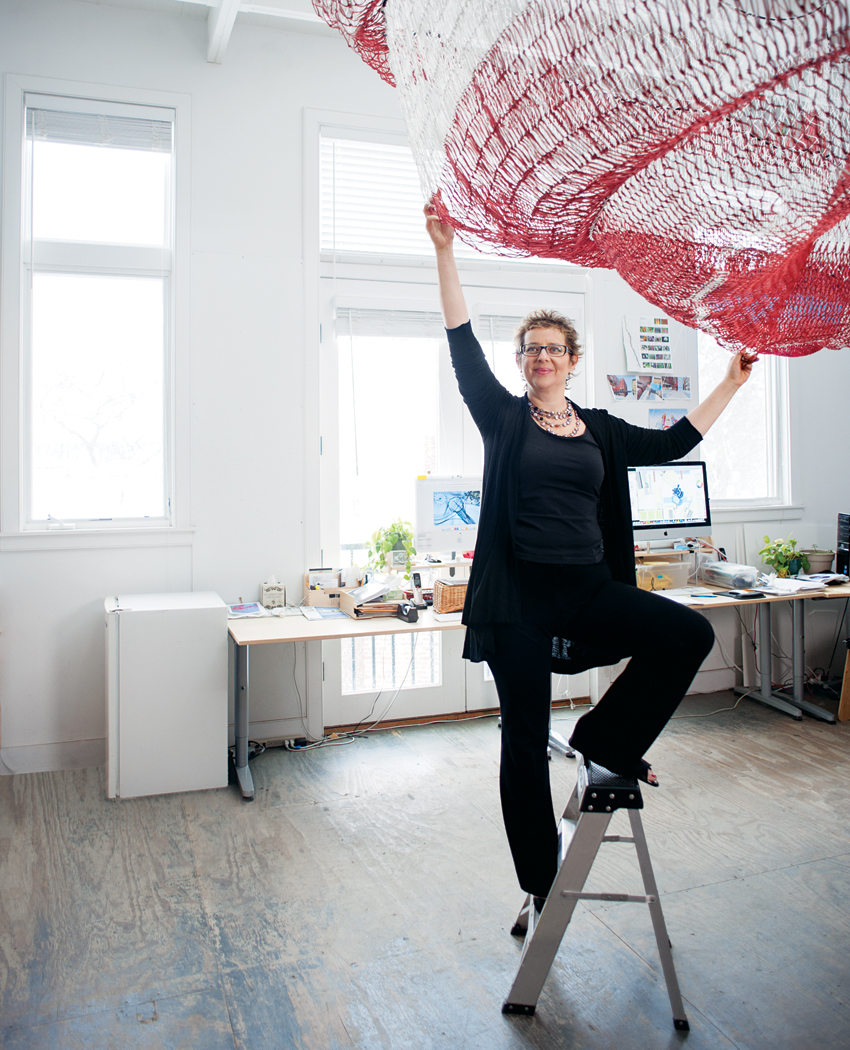Strings Attached

Photo by Jared Leeds
Janet Echelman’s sculptures—“Every Beating Second,” at the San Francisco International Airport, or the Teflon-fiber piece “She Changes,” in Porto, Portugal—float above public spaces, drawing the eyes heavenward.
Monumental, yet nearly weightless in appearance, her works’ apparent simplicity—much of it inspired by traditional fishermen’s nets and weaving—belies extremely complex engineering. To execute each piece, Echelman often collaborates with experts in a broad range of disciplines. In some cases, she has been the first to experiment with cutting-edge materials and technologies being developed at the MIT Media Lab or the Center for Bits and Atoms.
Though the artist has lived all over the world—including in Hong Kong, Indonesia, Japan, and India—for the moment, she’s comfortably ensconced in Brookline. “The depth and richness of intellectual life here—and the accessibility—is unique,” she says.
Echelman’s largest studio project yet will be unveiled in 2014. A collaboration between the artist and the custom engineering-software company Autodesk, the sculpture was commissioned to honor TED’s 30th anniversary in Vancouver. (Her 2011 TED Talk, “Taking Imagination Seriously,” has been translated into 33 languages.)
Learn about the many things that inspire Echelman’s work:
1. Building Forts
“As a child, I always enjoyed building forts by stringing up bed sheets and clothes,” Echelman recalls. “I continue to be inspired by makeshift structures, including my own kids’ forts and temporary architecture of all sorts.”
2. Visual Artists
Echelman’s favorites include Gordon Matta Clark (“The material of the built environment was his canvas,” she says), Louise Bourgeois, Henri Matisse (pictured above), and Michelangelo Merisi da Caravaggio.
3. Craftsmanship
“I find beauty in everyday actions that have been repeated and refined through the centuries,” she says, “from the way a fisherman makes his net to the way my neighborhood bakery, Clear Flour, crafts their perfect croissants.”
4. Urban Walking
When Echelman lived in New York City, she and her husband would often walk “fifty blocks on a date.” Now she adores “moving from the fish market to the hardware store, chatting with proprietors and neighbors along the way.”
5. Baroque Music
For Echelman, playing piano pieces from the Baroque period brings her right and left brain together. “I love the way a motif will amble from one hand to another,” she says. “I often turn to this as a model for how to create counterpoint in the city.”
6. Balinese Festivals
“Threading my way through purveyors of sweets and gambling, I’d enter the temple compound, where the sounds of multiple gamelan orchestras and dance performers mix in the humid air,” Echelman says. “The festivals touch all five senses.”
7. Waves
“Whether being battered by the surf or swimming through the gentle undulating surface of lakes, I find inspiration in the movement of water,” Echelman says. “Sometimes I think about the journey the water has traveled, reconnecting me to the larger cycles of nature.”
ON FILE
What I’m Watching
“TED talks: by spoken-word poet Shane Koyczan, Sir Ken Robinson on why schools kill creativity, and Jill Bolte Taylor’s experience of having a massive stroke and observing her brain functions of motion, speech, and self-awareness shut down.”
What I’m Drinking
“I squeeze half a lemon in a glass, add agave syrup, and fill with bubbly water. I learned to drink this in India as a way to break up the monotony of bottled water.”
What I’m Eating
“Striped eggplant, roasted in my toaster oven with slices of fresh tomato. If I were to write a cookbook, it would be called something like Toaster-Oven Cuisine for Busy Professionals with Little Time but Ample Taste-Bud Expectations.”
Where I’m Traveling
“This summer, I will make stops in Vancouver, Delhi, and Singapore. I spent the bulk of my twenties living in a Bali village, and I’m looking forward to returning to Southeast Asia and the flow of life there.”


